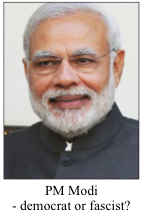India has been a jewel in the crown of democracy ever since it achieved independence in 1947. Despite mass poverty, religious and caste violence, insurgencies, separatism in Jammu and Kashmir, and feuds with its neighbours, it has remained democratic with respect for civil liberties, an active supreme court and a free press. However since the election of Prime Minister Narendra Modi and his Bharatiya Janata Party (BJP) in 2014, the country has begun to slide into strongman rule as the BJP increasingly recasts the country from a secular democracy to a Hindu state. The BJP is essentially the political arm (Read more…) the country’s main Hindu nationalist organization, the fascistic Rashtriya Swayamsevak Sangh (RSS).
Since Modi came to power, there has been an increase in discrimination and violence against minorities, including mob lynchings, with Muslims, the country’s largest minority, bearing the brunt. He has suspended Article 370 of the constitution which grants autonomy to Kashmir, India’s only Muslim-majority state. He has flooded the state with troops and detained hundreds of prominent Muslims. Recently, the BJP passed a citizenship law which allows non-Muslim immigrants from neighboring nations to seek citizenship in India, the country’s first law that explicitly excludes Muslims.
Under intimidation from Modi and his allies, the press has become remarkably docile and approving of Modi’s “New India.” By selectively pulling government advertising and pressuring private companies to follow suit, he has largely silenced mainstream media. And according to his deputy, Amit Shah, the BJP’s social media networks are an irresistible force.
Even the police have at times appeared intimidated, standing by or even participating during Hindu-Muslim conflicts. Courts, too, have been corrupted. The BJP have been rewriting school textbooks and renaming sites to fit the Hindu narrative. Meanwhile the RSS claims it runs thousands of schools and hospitals, a network of trade unions, the largest network of farmers, and the largest social-welfare organization working in the slums. A state unto itself.
Modi cut his political teeth in the state of Gujarat where he served as chief minister. During his tenure, riots killed thousands and drove tens of thousands from their homes. Evidence suggests the rioting was largely planned and directed by the RSS, possibly with government complicity. Thus his behaviour as prime minister is not a surprise. When Ashis Nandy, a trained psychologist, interviewed Modi during a study of the mentality of Hindu nationalists, he concluded that “Modi was a fascist in every sense.” He had a puritanical, authoritarian personality and an enormous ego guarding a gnawing insecurity.
Some Indians see a grim future in all this. According to Krishna Prasad, former editor of the newsweekly Outlook, “Gandhi and Nehru were great, historic figures, but I think they were an aberration. It’s very different now. The institutions have crumbled—universities, investigative agencies, the courts, the media, the administrative agencies, public services. And I think there is no rational answer for what has happened, except that we pretended to be what we were for fifty, sixty years. But we are now reverting to what we always wanted to be.”
Can this be true? Has India, like so many developing countries, always been more inclined to strongman rule than to democracy? Has 70 years of democracy been a fluke? It would be hard to lose India, not only a developing country but the second most populous nation on Earth. A loss of 1.37-billion people would be a heavy blow to the democratic project.

